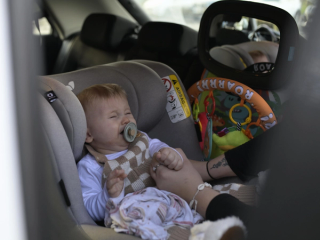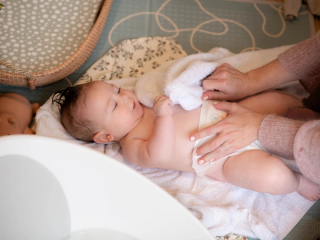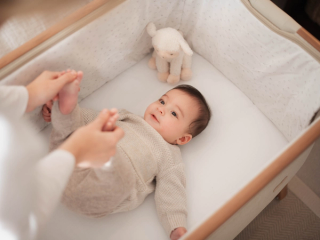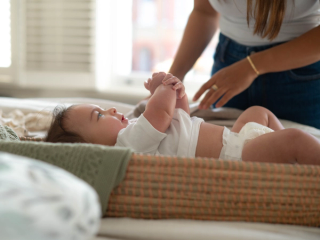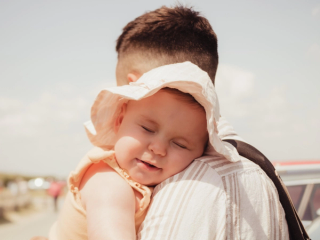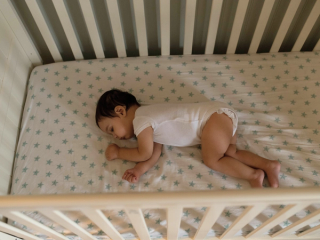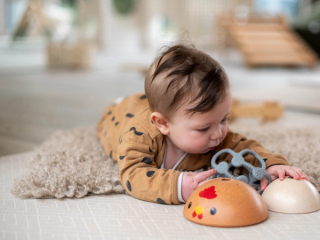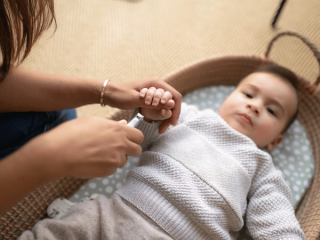
- Home
- Advice Hub
- Newborn
- Essential Newborn Care
- How To Keep Your Baby Warm In The Winter
How to keep your baby warm in the winter
Babies can't regulate their body temperature like adults can, so it's important to keep an eye on their temperature. Read our latest article on guidance on how to help your little one keep warm on those cold winter night.
When cold weather strikes, it can be really difficult to know whether your baby is warm enough – especially at night, when the heating tends to go off. As adults, we can choose to huddle under our duvets, add an extra blanket, a hot water bottle, or stick a foot out when we get too hot, but babies can’t regulate their temperatures like we can, so it’s important to get it right and keep an eye on both the room temperature and your baby.
What temperature should baby’s room be?
In the UK, we’re fortunate that winter temperatures don’t drop as dramatically as they do in other countries. However, when it’s sub-zero out there at night, inside temperatures can also dip.
It’s recommended that your baby’s room is between 16 and 20˚C, so make sure you have a room thermometer available so that you can keep track of the temperature. You may find your baby monitor has an integrated temperature sensor that will alert you when the temperature is outside the ‘Goldilocks zone’, but otherwise you can buy a room thermometer fairly cheaply and keep an eye on it yourself.
If you’re happy with the room temperature in the evening, but concerned that the temperature will drop below optimum levels during the night, you could move your thermostat (if it’s mobile) into the baby’s room. Set the temperature to a number you are happy with between 16˚C and 20˚C and leave your heating on. It will then only kick in if the room temperature drops below that happy level, and won’t heat your baby’s room beyond that temperature.
Do remember not to position your baby right next to a radiator, or any kind of heater, as there is a danger they could overheat. It’s wise also to ensure baby’s room is well ventilated, so you don’t end up with condensation, which can lead to mould and mildew forming.
What should baby wear to bed?
The next question of course is, how to dress your baby for bed and what to use in terms of blankets, sleeping bags, etc. The Lullaby Trust recommends that babies under one year do not have a duvet, pillow or quilt, as this is a SIDS risk. Instead, a lightweight baby blanket or baby sleeping bag is an ideal solution to keep baby warm at night.
Baby sleeping bags will keep your baby warm without blankets. They are available in different togs, just like a duvet, so you can get warmer ones (usually up to 3.5 or 4 tog) for the winter months and something as light as muslin for those hot summer nights. These sleeping bags often also come with guides as to how to dress your baby underneath their sleeping bag according to the temperature. For example, if the room your baby sleeps in is 16 – 18˚C, a sleepsuit under a 2.5 tog sleeping bag will keep them warm enough. If the room is colder than that and you can’t warm it up, put a vest under the sleepsuit to keep them cosy. Socks could be added if the sleepsuit doesn’t have feet, but you will probably find them in the bottom of the sleeping bag when you get them undressed the next morning! (Remember, your baby does not need to wear a hat indoors.)
If your sleeping bag does not come with a guide, have a look online and compare the tog of your sleeping bag with one of the major brands, which will have a guide on their website. (See Tommee Tippee as an example.)
If you prefer to use a baby blanket, make sure your baby is positioned with their feet at the end of their crib or cot, use breathable blankets (i.e. when you hold it up to your face you can breathe through it), and try to make sure baby is well tucked in without any loose bits of blanket that may present a risk. Tiny babies can also be swaddled to keep them warm, but follow safe swaddling guides to avoid the risk of overheating.
What are the signs a baby is cold at night?
The best way to check the temperature of your baby is to touch the back of their neck or their chest with your hand. (Don’t try this if your hands are cold! You’ll probably wake your baby up, and you won’t get an accurate reading.) These areas of their body give you the best picture of their temperature, whereas extremities like hands, toes and noses are more likely to be cold in a cold room, so don’t take this as a sign that they’re not warm enough.
Generally speaking, if your baby is feeling the cold, they will be unsettled and won’t sleep well. If your baby is sleeping normally (whether that’s an 8-hour stretch, or waking every hour!), they are probably comfortable.
What about naptime?
The house is usually warmer during the day, and babies typically have an extra layer compared to at bedtime, so check the room temperature where your baby is napping and then judge whether you need to strip them off a bit before you put them down for a nap. If in doubt, you could go for a full change into sleepsuit and sleeping bag. They’re unlikely to need a sleeping bag or blanket on top of a normal daytime outfit.
If you’re bringing your baby into the house from outside, and they have fallen asleep wrapped up for the cold, it’s important to take some layers off so that they don’t overheat – even if that means waking them up. It’s especially important not to leave them in outside clothes in a buggy or car seat once you’re inside the warm house – or even in a warm car. Take off snowsuits/coats, hats and gloves once you’re in the warm and give them the chance to regulate their body temperature.
Advice & tips

Want to read more? Join the HiPP BabyClub for full access to this article.
As a BabyClub member, you'll get access to a range of exclusive benefits, including:
Monthly competitions
Discounts from our Partners
Expert advice tailored to your little one's age
Weaning recipes
HiPP shop discounts*
*10% off HiPP's online shop does not apply to our First Infant, Anti-Reflux or Comfort Formula Milk.
Important notice: Breastfeeding is best. Follow on milk should only be used as part of a mixed diet from 6 months. Talk to a healthcare professional.




